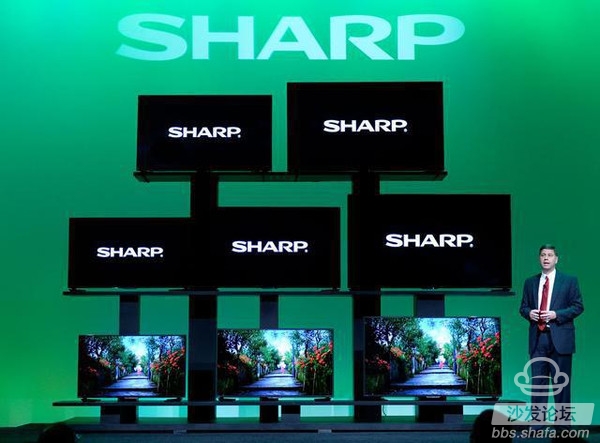The original silent August was broken by Hisense's acquisition of Sharp Americas. For many years, Sharp's color TV market has been included in China Hisense. As more foreign big names are acquired by domestic brands, what are the prospects for China's color TV market?
Skyworth recently announced the acquisition of Japan after Skyworth acquired Xoceco's South Africa subsidiary and Germany’s Metz Television, TCL Multimedia’s acquisition of Japan’s Sanyo Electric Mexican TV plant and assets, and TCL’s absolute control of Toshiba TV’s joint venture company Toshiba Video Products China Ltd. Sharp's TV business in the Americas (except Brazil), Sharp Mexican TV companies and assets.
According to the home network, as early as the beginning of this year, when Sharp Corporation reported a huge loss, there was media coverage that Sharp researched and sold Mexican TV plants and withdrew from the North American TV market. Therefore, Sharp's total withdrawal from the American television market is Sharp's neat color TV reform measures in recent years.

"Slow Sheep" - Sharp
In 2014, Sharp took the decision to completely withdraw from the home appliance market in Europe, and at the same time transferred color TV production, sales, and white goods production and sales to two counterparts in Slovakia and Turkey.
Judging from the global industrial trend, 2014 was the global exit year of Panasonic TV. Matsushita completely abandoned its plasma TV and panel business. In 2015, it was the global exit year of Toshiba and Sharp TV. Toshiba has completed the color television from Europe and North America. The complete exit of the market is expected to complete a complete exit from the Asian market (except Japan) during the year.
According to HomeNet's observation, Sharp and Panasonic and Toshiba are different. The latter two companies currently have new profit pillar businesses, Matsushita’s automotive and residential business, Toshiba’s nuclear power and infrastructure business, but Sharp’s current main business is still LCD and Home appliances.
Taiwan’s Hon Hai Group Chairman Terry Gou said at the shareholders’ meeting in June this year that Sharp’s problems are complex and have face factors. He is willing to cooperate with Sharp, but Japanese companies’ decision-making is slow and they can only wait patiently.
Since the end of the last century, Sharp has invested heavily in the construction of LCD empire, known as "the father of LCD." If it is not a huge loss year after year since 2011, Sharp may still be the world leader in the LCD industry.
As Terry Gou said, slow decision-making is a major factor in sharp declines in recent years. Take Hisense's acquisition of Sharp's American television business as an example. Since the company completely withdrew from the European home appliance market in September last year, it has been almost one year before Sharp decided to shake off the US color TV business, and it will not be delivered until January 2016.
According to Home Power's review of Sharp's announcement, Sharp Mexicana Mexico SA de CV (SEMEX), a Sharp color TV company in Sharp, can only maintain a net profit of US$4.414 million and US$4.346 million in fiscal year 2012 and 2013. At the end of March, it was a net loss of $128,340.
If it is not a huge loss, Sharp may not necessarily quickly decide to sell the TV factory to Hisense at a low price. This also reveals that Sharp's business decisions in the past few years lag behind changes in the market environment.
Hysteretic television reform
According to the understanding of the home network, the decline of Japanese color TV companies has already begun to show signs since 2013. Typical events include Panasonic's closure of the Shanghai Plasma Factory, Toshiba's closure of the Dalian TV Plant, Sony's spin-off TV business, and subsequent major Japanese TV color TV strategic shrinkage. Sharp alone has no visible reforms in the TV business.
Take the North American TV market as an example. Due to the low price competition between South Korean and Chinese manufacturers, Sharp has launched a high-resolution large-size LCD TV sales strategy in the US market, hoping to gain an advantage over 60-inch products, and only Sharp had at the time. LCD panel tenth generation line.
However, after taking the shares of Sharp SDP's Tenth Generation Line in the form of individual funding, Gou worked together with Sharp and turned to Foxconn to collaborate with LeTV to create a super TV, using the SDP tenth-generation panel. Gou also used the tenth generation line panel in his own TV brands, such as the RadioShack TV, using the tenth generation line panel, which is sold at a low price in the United States. The same panel is cheaper than the Sharp TV in the United States. many.
Sharp China and LeTV also took a stand on this matter. At that time, LeTV marked Sharp as a partner and was denied by Sharp China. Then LeTV changed its mind to say that it was not Sharp. Super TV used SDP's tenth-generation panel.
Sharp TV's most proud advertisement in China's color TV market is the original tenth-generation line imported from Japan. But now, the secret of the Sui and Dynasties line panel factory from loss to profit in the hands of Terry Gou, the secret to earning money for several years in a row is to expand suppliers, which is totally different from Sharp's exclusive management style in the past.
Where does the Chinese market go?
As we all know, in the early days, Japanese panel companies restricted their supply in order to establish their own unique technology and product advantages. For example, Panasonic's plasma TV panel, exclusive technology control, China TV manufacturers want panels, people do not necessarily give, many companies changed their camp to the LCD camp. When Sharp invested heavily in the construction of the Tenth Generation Line, the panel produced was naturally the best priority for its own television.
In the brilliant era of Sharp TV, this strict supply restriction brought huge profits to Japanese companies. However, Sharp's vertical management system began to suffer a huge crisis under fierce price competition.
After peeling off Europe and the Americas, Sharp's largest operating position in the world has only left the Chinese market, and Sharp has a TV manufacturing facility in Nanjing. In the same year that it wants to use the large-size TV to force the U.S. market, Sharp may have hope for the performance of the color TV business in the Chinese market, such as the 4K TV that is mentioned in the financial report.
At present, the sharp brand in China's color TV market is still relatively influential, is to take the initiative to dispose of a good price when the valuation is high, or like Europe, the Americas, when the loss is unable to support the time when forced to low-cost transfer?
From the standpoint of the Japanese company’s color TV strategy, Sharp’s Japanese counterpart Sony has made it clear that TV is not the engine of future growth. Panasonic shut down its last television factory in Shandong, China. Toshiba dumped China’s TV business to TCL, dismissing China in disguised form.†"Sharp decision-making," Sharp, after selling the Americas television business to Hisense, will face the future of the Chinese market.
This content is copyrighted exclusively by SofaNet. Welcome manufacturers to further exchanges and cooperation with us to create more in-depth product reports.

Smart TV box recommended to install sofa butler, download address: http://app.shafa.com/
Sofa Net is an Internet technology company specializing in smart TVs and boxes. It owns popular products such as sofa butlers, sofa tables, and sofa forums. It has been committed to providing high quality application resources for smart TV and TV box users and active community exchanges. And authoritative evaluation of smart TV products.
Brightness Led Outdoor Lamp,Led Moisture Proof Lamp,Ip65 Waterproof Led Lamp,Moisture Proof Lamp
jiangmen jieken lighting appliance co.,ltd , https://www.jekenlighting.com